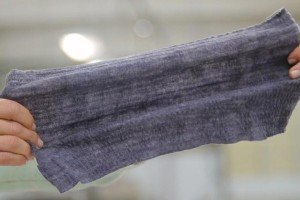Add Conformance to Your Nonwoven Substrates
Conformance can be achieved by enhancing a combination of properties. Extensibility, stretch and too a lesser degree drape and hand all are component of conformance. Machine direction extensibility can be added to products by matching the Micrex Process with a range of nonwoven substrates. Micrex Technology can achieve this at a much lower cost than using elastomeric filaments or film.
Extensibility and stretch are properties that are often confused with one another. Product needs are often expressed in terms of stretch, but actually the desired property is often extensibility with a limited degree of recovery.
Extensibility is often interpreted as “comfort”. In other words, an inelastic product is not usually rated as highly in comfort as one that has an appropriate level of extensibility. Extensibility in itself is useful for applications such as medical gown belts, conformable packaging, under-cast padding, as well as other low-tension end uses where regain is not desirable.
Stretch is usually measured as the extension of a % of the compacted form followed by recovery. Limited stretch has advantages that allow the designer to customize and control maximum extension. In some cases too much extension is undesirable. In others, controlled (limited) tension is necessary. An elastic (e.g. rubber or spandex) continually increases tension and can’t be tensionless. A Microcreped nonwoven can have controlled extension, and as a result can meet design requirements.
Regain (recovery) from stretch varies depending on the substrate’s weight and especially the polymer. Nylon and polyester have good resilience. Polypropylene is softer and has lower resilience (regain), but may still be adequate for Microcreping. In some cases polypropylene regain can be increased by adding weight. Regain is usually expressed as a % of the original length after stretching at a specific energy level (e.g. 80% recovery after 50% extension).
Resilience
Resilience is often acceptable at a level of extension less than maximum (e.g. 25% in use where 50% is regain). Resilience can be greatly influenced by the angle of fibers relative to the direction of stretch. For example, a substrate that stretches in the MD, with fibers that are mostly oriented in that direction (i.e. a carded web) will (all other things being equal) have much better regain than a spunbond with fibers laying in random directions and will on average have less than 50% MD fiber orientation. The bottom line: the closer the creped fibers are oriented to the machine direction, the more they can help your nonwoven regain or recover from stretch.
Two-Way (sometimes referred to as Four-Way, Bi-Axial, Harmonized) Stretch:
In some applications stretch is desired both MD and CD. By combining The Micrex Process with a substrate with CD stretch (such as spunlace without cross-lapping), two-way stretch can easily be achieved.
Other Properties
Secondary properties are of equal importance. In interlining, requirements include washing, machine drying, solvent dry cleaning, and steam pressing / ironing. In diapers the key secondary characteristics are softness and attachment to other components. Industrial applications have a broad variety of additional requirements, such as controlled internal volume (for wicking), abrasion resistance, etc. Here is an example of how stretch can influence secondary characteristic performance: a nonwoven that stretches when in an abrasive environment may allow fibers to absorb the abrasive energy by extending rather than breaking.

